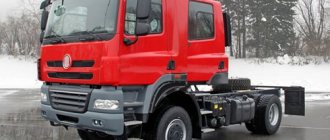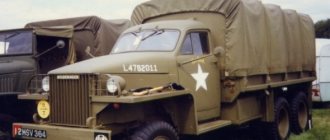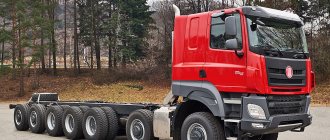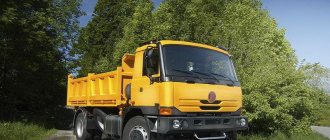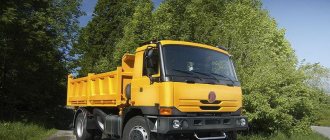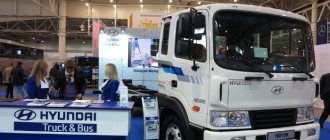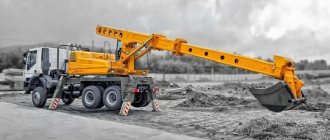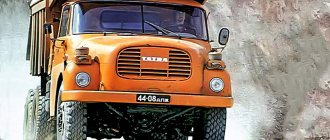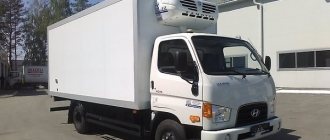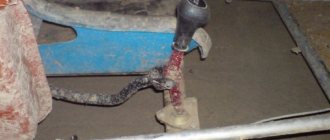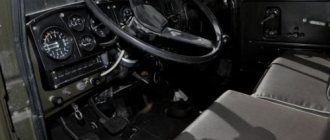History of appearance
In the 2000s, the global automotive industry developed a tendency to absorb small manufacturers by larger ones with solid financial resources.
By 2010, Tatra was already ready to go under the wing of a serious car manufacturer. As a result, Tatra and DAF merged.
For fifteen months, a joint group of designers and constructors developed a new truck. The result of their efforts is TATRA PHOENIX.
The engineers took the unique Tatra frame as a basis. This is the so-called spine structure. The basis is a pipe made of spring steel.
Photo: Tatra Phoenix with crew cabin
It has high strength characteristics and is resistant to torsion. Thanks to this pipe, the propulsion system and transmission are reliably protected. Considering that these are mainly quarry vehicles, such protection is a big plus for the car.
The heaviest units are installed on this base - the internal combustion engine, gearbox and transfer case. A subframe for the cab and body, as well as split axles with independent suspension, are attached to the pipe. The axle shafts on the bridges are swinging. This increases the vehicle's maneuverability over difficult terrain.
You can get acquainted with the technical characteristics of the Ural-4320 in our review. And here you will learn the history of the creation of the Tatra 815 dump truck.
The main difference from previous Czech-made models is the DAF CF85 cab in a daytime version and with a sleeping bag. There are comfortable soft seats inside. The driver has an air-suspended seat, adjustable in all directions.
The dashboard is very similar to that of a passenger car. It is made of high quality soft plastic. The only difference is that under the right hand there is a handle for an additional two-speed gearbox and buttons for disabling the differentials.
The engine has changed. Now Phoenix engines are equipped with American-made PACCAR MX diesel engines in four modifications, with power ranging from 360 to 510 hp. With.
Currently, versions of the Phoenix are available that have all-wheel drive with two, three, four and even five axles. Accordingly, these are cars with wheel formulas 4x4, 6x6, 8x6, 8x8.
By special order, trucks with a 10x10, 10x8 or 10x6 wheel configuration can be manufactured.
Moreover, they will have a controlled fifth axle. This significantly increases the maneuverability and maneuverability of the Tatra.
The main modifications are trucks with replaceable dump bodies of various carrying capacity.
Characteristics of the base model
| Vehicle marking | TATRA PHOENIX T158 8P5R32 6x6.2 |
| Geometric dimensions of the machine | 7 840x2 550x3 440 mm |
| Track | Front - 1992 mm, rear - 1778 mm |
| Ground clearance | 280 mm |
| Maximum transported cargo weight | 16,500 kg |
| Weight of the vehicle fully loaded and loaded | 30,000 kg |
| The highest load on the first axle | 9,000 kg |
| Largest load on rear axles | 11,500 kg each |
| Wheel configuration | 6x6 |
| Power point | PACCAR MX265 HD |
| Environmental standard | Euro 5 |
| Possible climbability with full load | 45 degrees |
| Minimum turning circle for outer wheel | 18 meters |
| Wheels | 315/80 R22.5 |
The vehicle is equipped with a 10 cubic meter dump body. m. It is heated by exhaust gases. The side board at the rear of the body increases the transported cargo volume.
In the standard version, the power plant is equipped with pre-heating of spark plugs before starting the internal combustion engine and a heated separator as a fuel filter.
The front axle has a plug-in drive and swing axle shafts. The axle differential is equipped with a lock.
The rear axles also have swing axles, and springs have been added to the suspension.
Several independent braking systems are mounted on the Phoenix chassis: main (working) with ABS, emergency, parking and retarder.
Transmission - ZF mechanics with sixteen direct gears and two reverse gears. There is an auxiliary box made by TATRA with two stages.
Design features T158 8P5R36 6×6.2 R
This Phoenix model, having a 6x6 wheel arrangement, thanks to the reinforced suspension and large tire size, has the ability to transport larger and heavier cargo.
This car has a Paccar MX300 HD diesel engine. This is a power plant designed to work in harsh conditions. Its power is 408 hp. With. with a torque of 2,000 Nm. Fuel capacity - 345 liters.
The front suspension has hub gears and a torsion bar. Pneumatic springs and shock absorbers provide a maximum load on the front axle of 9 tons.
The suspension on the rear axles is combined. It is mounted on leaf springs and air springs. This combination allows you to increase the axle load to 16 tons. The wheels are fitted with R24 tires.
All this, together with a square-shaped body with a closing tailgate, allows you to transport a load weighing 25.5 tons and a volume of 17 cubic meters. With a gross weight of 41 tons, this Phoenix is capable of climbing steep climbs. In one of the test drives, the tester went up and down a sandy slope, which the Land Rover Discovery had to overcome with great difficulty.
The test result was positive. At this obstacle, the Tatra Phoenix with six driving wheels did not experience any difficulties, overcoming the sandy slope in a short time without slipping.
You will be interested in familiarizing yourself with the technical characteristics of the GAZ-33081, which are discussed in our article. At this address: https://spez-tech.com/tehnika/gruzovie-avto/tatra/148-opisanie-sfera-primeneniya-harakteristiki.html you will find a video of a test drive of the Tatra 148 crane.
In this review, we looked at the technical characteristics of the GAZ-66 and told the story of its creation.
The upper location of the air intakes allows you to cross deep water obstacles and move for a long time in the aquatic environment without damage to the engine and life support systems. This is also facilitated by a ground clearance of 350 mm.
As an option, a “northern package” can be installed on the car, which provides heating for all the most important car systems and also has a battery charger on board the car.
Tatra 815-7
The development of specialized heavy army trucks of the 815-7 series was completed in 2004, and they were initially designated Tatra 817. The vehicle combines the chassis of the Tatra 815-2 Armax vehicles, which appeared in 1999 (their assembly was discontinued in 2012) , and a specially designed utilitarian cab with a lower height.
The modular principle retained in the design of these machines made it possible to form a line with a wheel arrangement from 4x4 to 10x10. The supporting pipe of the vehicles is connected to a spar frame designed for mounting bodies and superstructures. Together they form a three-dimensional structure with very high torsional and bending rigidity. The vehicles have front and rear suspension on air springs with telescopic shock absorbers, thanks to which they got rid of the “clubfoot” characteristic of Tatra trucks of previous series. The ground clearance, depending on the tire size, is 380–410 mm and can be temporarily increased or decreased by the suspension. “Sagging” of a car is used when transporting by transport aircraft. The drive of the front axle (or axles) is switchable. The chassis has wheel reducers and locking mechanisms for axle and center differentials. All cars are equipped with a centralized system for regulating air pressure in tires, and some models are equipped with a winch.
The cabin configuration allows the vehicle to be transported on the C-130 Hercules transport aircraft, and also facilitates the installation of armor, which can be made according to level 2b of the STANAG 4569 standard (withstands an armor-piercing incendiary bullet from a 7.62 mm cartridge from a distance of 30 m and undermining the bottom of an anti-tank high-explosive mine with 6 kg of explosive).
To reduce the silhouette, the power unit is moved back in comparison with Armax machines. The cab has two main seats and one additional seat and is currently only available in the extended length version. In order to protect against the effects of weapons of mass destruction, it can be equipped with equipment to create excess pressure inside it.
The main power units for this line are various modifications of the air-cooled Tatra T3C-928 V8 diesel engine. The engines have a displacement of 12.7 liters, a power of 326, 367 or 408 hp, are equipped with a turbocharger with an intercooler (charge air intercooler) and comply with the Euro 3 environmental standard. Most models have manual 14-speed Tatra gearboxes, but the cars 8x8 type is also equipped with Allison automatic transmissions. Upon request, vehicles with Tatra gearboxes can be equipped with the Tatra-Norgren electronic gearshift system.
The first in the series was the two-axle 7-ton flatbed truck Tatra 817-7B0R42 14 202 4×4.1, exhibited at several international arms exhibitions in 2004–2005. In 2005, the vehicle index was changed from 817 to 815-7, and in 2007 the start of mass production was announced. However, back in 2004, the 817-7MPR89 model with an 8x8 wheel arrangement participated in a competition for the supply of trucks for the South African army, and in 2005, the five-axle version 815-7E0R89 with a hydraulic multi-lift loading and unloading device was tested on behalf of the American company Truck Company as part of the LVSR (Logistic Vehicles System Replacement) program for possible adoption by the US Marine Corps.
In October 2009, Tatra entered into an agreement with the American company Navistar Defense (the military division of the Navistar automobile corporation) to jointly develop military trucks and sell them on the international market. The cars of the American-Czech alliance were Tatra 815-7 cars equipped with 6-cylinder Navistar MaxxForce D 12.4 diesel engines with a power of 450 hp. and 6-speed automatic transmissions from Allison. In 2010, a 6x6 container ship Navistar/Tatra ATX6 and a flatbed truck with a Navistar/Tatra ATX8 8x8 hydraulic crane were demonstrated at the Eurosatory 2010 exhibition in Paris. The military departments of Canada and South Africa tried to get interested in these machines, but there were no orders for them.
Currently, the factory production program includes the following models of the 815-7 series:
– 815-7L0R59 19 257 4x4.1R – 4x4 flatbed truck with a load capacity of 8500 kg. The gross vehicle weight is 19,000 kg. Engine – diesel Cummins ISLe 350 with a power of 350 hp;
– 815-780R59 19 270 4x4.1R – 4x4 flatbed truck with a load capacity of 8500 kg. The gross vehicle weight is 19,000 kg. Engine – diesel Tatra T3C-928-81 with a power of 367 hp. Available in both container carrier and tanker versions;
– 815-790R39 29,300 6x6.1R – 6x6 type container ship with a carrying capacity of 15,900 kg. The gross vehicle weight is 29,000 kg. Engine – diesel Tatra T3C-928-90 with a power of 408 hp;
– 815-7M0R39 29 306 6x6.1R – 6x6 type container ship with a carrying capacity of 17,000 kg. The gross vehicle weight is 29,000 kg. Engine – diesel Cummins ISMe 420 30 with a power of 416 hp;
– 815-790R99 38,300 8x8.1R 8x8 – 8x8 type chassis with a load capacity of 24,700 kg. Gross weight – 38,000 kg. Engine – diesel Tatra T3C-928-90 with a power of 408 hp. Available as a flatbed truck with a carrying capacity of 21,100 kg, a container carrier, a fuel tanker with a capacity of 18,000 liters, and can be equipped with a multi-lift device;
– 815-7M0R99 38 306 8x8.1R – 8x8 type container ship with a carrying capacity of 24,500 kg. The gross vehicle weight is 38,000 kg. Engine – diesel Cummins ISMe 420 30 with a power of 416 hp. The gearbox is automatic, Allison.
The Tatra 815-7Z0R9T 44 440 8x8.1R line is completed - an 8x8 chassis for the KWZT-1 Mamut recovery vehicle from the Polish company Pojazdy Specjalistyczne Zbigniew Szczesniak. Mamut was first shown at the IDET 2011 exhibition in Brno. The tow truck has a 12-ton crane with a maximum boom reach of 8.4 m, two main winches with a force of 24 tons, an additional 2-ton winch and a rear fork with a lifting capacity of 14 tons. A bulldozer blade can be installed as additional equipment. Curb weight in the version with an armored cabin is 35,000 kg. Engine – diesel Deutz TCD 2015 V08 with 598 hp. Transmission – Allison, automatic.
Vehicles of the Tatra 815-7 family are supplied to the armies of the Czech Republic, Slovakia, India and the Indonesian Marine Corps. Since 2010, civilian versions of these trucks, including fire trucks, have also been available. Thanks to the low cab height, the chassis is well suited for the installation of fire escapes and cranes. Navistar Defense continues to advertise the “Americanized” Navistar/Tatra ATX6 and ATX8 to no avail.
In addition to trucks, the company assembles chassis without a cab for mounting armored hulls. These currently include the following models:
– 815-7A0R59 19 240 4x4.1R – 4x4 type chassis with a front control station with a load capacity of 11,060 kg. Gross weight – 19,000 kg. Engine – Tatra T3C-928-A0 with 326 hp. There is a variant 815-7APR59 19 240 4×4.1R with right-hand drive;
– 815-790RK9 19,300 4x4.1R – 4x4 chassis with a load capacity of 10,400 kg with a front engine. Gross weight – 19,000 kg. Engine – Tatra T3C-928-90 with a power of 408 hp;
– 815-790R39 29,300 6x6.1R – 6x6 type chassis with a front control station with a load capacity of 18,760 kg. Gross weight – 29,000 kg. Engine – Tatra T3C-928-90 with 408 hp. There is a variant 815-79PR39 29 300 6×6.1R with right-hand drive;
– 815-790RK9 29,300 6x6.1R – 6x6 chassis with a front engine with a load capacity of 18,800 kg. Gross weight – 29,000 kg. Engine – Tatra T3C-928-90 with a power of 408 hp;
– 815-790R99 38,300 8x8.1R – 8x8 type chassis with a front control station with a load capacity of 25,000 kg. Gross weight – 38,000 kg. Engine – Tatra T3C-928-90 with 408 hp.
The first to borrow the chassis from the 815-7 series was the Israeli company IMI. In 2005, together with the American Truck Company, it developed on its own initiative, based on the Tatra 815-7L0R42 4x4 truck, the Wildcat multi-purpose armored vehicle with three types of modular overhead ballistic protection. The vehicle was brought to the stage of mass production and was tested in the US Marine Corps in 2008, but was not accepted for service.
Since 2009, the Brazilian company AVIBRAS has been producing AV-VCC armored command vehicles for the ASTROS II MK5 multiple launch rocket system on the Tatra 815-7A0R59 19 240 4x4.1R forward control station chassis. On a 4x4 chassis with a front engine, the Czech company SVOS developed the VEGA multi-purpose armored vehicle in 2011 and has been promoting it on the arms market since 2013.
Chassis type 815-790R39 29 300 6x6.1R has been used since 2009 by the Brazilian company AVIBRAS as a base for the AV-LMU launcher and support vehicles for the ASTROS II MK5 multiple launch rocket system. All of them are equipped with armored cabins.
A very unusual machine called MFD (from Modular Flexible Drive) based on a four-axle chassis was shown at the Eurosatory 2010 exhibition by the German company Drehtainer. Combining a large usable hull volume and level 3b armor protection according to the STANAG 4569 standard, it is a module for forming field hospitals and mobile camps. The supporting body has doors both on the sides and at the rear, which allows you to create combinations of several machines installed close to each other. In 2011, on an 8x8 chassis, the Slovak company Vy/voj Martin built a container ship with an armored cabin, the Tatrapan 8x8 SS. It is currently being tested in the Slovak Army.
Technical specifications T158 8P5R46 8×8.2
A truck with a Tatra Phoenix dump body with a gable tire and eight driving wheels is the heaviest vehicle in the Phoenix line.
It is equipped with a 460 hp engine. With. and four drive axles. Moreover, connecting all-wheel drive to axles is possible from the cab while driving.
| ICE | Diesel, power 460 hp. With. |
| Environmental standard | Euro 5 |
| Track | Front - 1,984 mm, rear - 1,780 mm |
| Ground clearance | 350 mm |
| Maximum weight of transported cargo | 32,500 kg |
| Fully loaded machine weight | 50,000 kg |
| Heated body volume | 18 cu. m |
| Highest speed | 85 km/h |
| Minimum turning diameter | 21.5 m |
| Uphill slope that can be overcome with a weight of 50 tons | 55,00% |
| Rear suspension | On spring leaves with air cylinders |
| Wheels | R24 |
A high load capacity of 32.5 tons is possible on this machine thanks to the “spine” frame design.
In cars for Russia, a ZF manual gearbox is installed. A large range of direct gears allows you to easily overcome off-road areas with difficult terrain.
For European consumers, the AS-Tronic automatic transmission is most often installed. When driving on roads with artificial turf, this significantly saves fuel. Savings of up to 2 liters per 100 km are also facilitated by disabling the all-wheel drive of one axle.
The new Tatra Phoenix has been tested at the Surgutneftegaz association - Maxim Chernyavsky visited there
Have you heard the expression “like a phoenix from the ashes”? So the Czech Tatra is now trying to be reborn like a Phoenix... That is, like a Phoenix, and not from the ashes, but from oil! The new Tatra Phoenix was tested at the Surgutneftegaz association - I visited there.
Tatra driver Nikolay has been working “in the north” for 25 years
The Khanty-Mansiysk Autonomous Okrug, or Yugra in the local dialect, is a reserve of trucks, and not ordinary ones, but off-road ones. Here, only Gazelle ambulances and city buses are not equipped with all-wheel drive! And, perhaps, there is no European brand of all-wheel drive dump trucks that the rich Surgutneftegaz would not operate. MAN and Scania, Mercedes and Volvo, Iveco (mostly Russian-assembled, from Miass)… Not to mention the Czech Tatra. This brand has been famous here since Soviet times, when the Czechs produced 15 thousand trucks a year and half of this quantity went to the USSR. There was a saying: “The Magiruses built the BAM, and the Tatras built Siberia.”
Of course, times are no longer the same, and recently Tatra, with its specific products and small production volumes, almost went to the bottom thanks to the efforts of its American owners. And yet the plant survived: in 2013, it was bought by Czech owners, managing to sell about 700 cars. True, only 69 copies of them were in Russia.
The current hope of the Czechs is the Tatra Phoenix, which we talked about back in AR No. 20, 2011: leaving the traditional chassis with a tubular backbone frame and swing axle shafts the same, the Czechs borrowed the cab, engine, and at the same time ZF gearboxes from the mass-produced DAF CF model, and you can even order the “robot” ZF AS-Tronic. The car turned out to be successful, but small-scale: to date, only about 500 copies have been produced. The dump truck I met has serial number 239, and the vehicle was made in September 2013.
For 511 km - 308 liters of diesel fuel. This means the average consumption is 60.3 l/100km
In addition to diesel fuel, urea must also be added here: the engine is Euro-5
The “ski” under the cabin prevents the frame-pipe from digging a “trench”
0 / 0
And here I am - at one of the “bushes” an hour’s drive from Surgut, in a quarry where dump trucks are loaded. A Mercedes Actros 3341 6x6 in the signature blue and white livery of Surgutneftegaz pulls out from under the excavator, followed by its competitor MAN TGS 40.400.
And here is our “Tatrochka”, as the Czechs call her. First of all, it is four-axle, with an 8x8 wheel arrangement that can turn into an 8x4 (the front axles are disabled, which reduces fuel consumption on the highway). The tires are wide single-pitch “bast shoes”, and the rear ones, with a landing diameter of 21 inches, are larger than the front ones, 20 inches. The engine develops 462 hp, which corresponds to the “ten horsepower per ton” rule: the total weight of the vehicle, as indicated on the sign in the cockpit, is 46.4 tons, and according to the specification - all 50 tons. Impressive!
The headlight grilles are screwed on. To the left is the towing eye mount.
Behind the cabin there is a mandatory “separator” filter
The frame is tubular, but there is also a subframe - the body is attached to it
0 / 0
If you look under the dump truck, you can see the famous backbone frame - a powerful alloy steel pipe in which the cardan shafts and main gears are hidden. True, because of it, during repairs it is difficult to get to the engine and gearbox from below, but the pipe perfectly protects them, since they are located higher. But why is there powerful engine protection here if it is already covered from below by a pipe? It turned out that this is something like a ski that does not allow the Tatra to cut a deep trench with its pipe, but dump trucks of other brands simply will not pass after the Phoenix!
By the way, the ground clearance here is solid, 35 cm, but the gap between the wheels and the body is small, given the large strokes of the independent suspension with pneumatic elements.
Alive, smoking room! On the track - Magirus-Deutz from the "Bama" batch of 1974
And this “column leader” is a rare American Kenworth K500 with a DAF XF cab
0 / 0
The body of the Czech brand Porgest holds 22 cubic meters of rock, and it bends around the wheels of the second axle: a solution that is not very technologically advanced, but lowers the center of gravity. There is also heating of the body with exhaust gases, however, according to the operators, it is “so-so”, but this is an inevitable price for the colder exhaust of Euro-5 engines. But the car has an “Arctic package” with a full set of heaters: a “separator” filter, an engine, a gearbox, batteries (their liquid heating is “embedded” in the engine cooling system), a tank with urea and its pipelines. The package also includes “hood insulation” - that is, a false radiator grille.
It was a mistake for the Czechs to fasten the protective grilles of the headlights with star bolts: it’s inconvenient to wipe the headlights, and it’s also inconvenient to change them if they break. And the plastic lining around the towing eye mount on the front end is already split: this would be a powerful towing pin in the bumper, like the new Scania or Volvo dump trucks!
Tatras are veterans of Russian construction projects: model 815 has been produced since 1983
This is a restyled Tatra Terrano
And this is the “nosed” Tatra Jamal
0 / 0
The cabin is familiar from the old DAF CF tractor of our expert Nikolai Panov: I drove around Europe in this one for half a month. Only here it is planted much higher, and you have to climb using additional steps. And since there is no “sleeping bag” in the dump truck cabin, there is little space left for bags and things. However, dump trucks are usually driven alone and clothes are placed on the right seat.
Overboard - minus 15 with wind, and our driver Nikolai is sitting in his shirt. It’s just Tashkent here, as the drivers say: the cabin volume is small, and there are already two heaters, a regular liquid one and an independent air one.
Tatra, loaded to the top with frozen sand, floats majestically and smoothly along the dirt road. Just now I was bouncing along it in the UAZ I drove from Surgut, and now where have the holes disappeared? Noise insulation is also excellent: the engine rumbles quietly, and the driver and I talk in low voices. He has been working “in the north” for a quarter of a century: he started with a MoAZ scraper and drove, perhaps, all the local brands of trucks, including Steyr and the hooded MAN. Nikolay likes the new dump truck: “It’s a real Tatra, but much more comfortable.” Moreover, there is enough power, the Phoenix holds the road excellently, and on the highway it confidently accelerates to a maximum of 90 km/h.
There is heating of the body with exhaust gases, but, according to the operators, it is not hot enough. Tatra Phoenix in the Euro 6 version received a different “face” and headlights
I looked at the on-board computer: average fuel consumption is about 60 liters per hundred. By local standards, this is not much: the consumption of “European” dump trucks here can reach up to 150 l/100 km! But the disadvantage of this “tatro” during operation is its weight. How to pull out a 50-ton monster if it gets stuck? Only with a crawler bulldozer.
But the main problem is different. With a price of 200 thousand euros, this Tatra is more expensive than all its competitors! Therefore, representatives of Tatra suggest comparing their dump truck not with conventional ones, but with articulated ones - and against their background, it wins both in price and in size (since it can drive on public roads), not to mention fuel consumption.
As for the vehicle discussed in the article, Surgutneftegaz never bought it, but ordered five less heavy Phoenix 8x8 dump trucks. After Surgut, the car was sent to Vladivostok, and then it should be tested in Khabarovsk, Chelyabinsk and the Novolipetsk Metallurgical Plant.
Meanwhile, Tatra announced the creation of the Phoenix model in the Euro-6 version: it differs not only in the engine, but also in the headlights from the restyled DAF Euro-6, and in a different cladding. The plant is doing well: in 2014 it plans to produce more than 800 trucks. It’s just a pity that our country has ceased to be the main market for Czechs...
The body “with a slide” can accommodate 22 cubic meters of rock, and the declared load capacity is 32.5 tons
